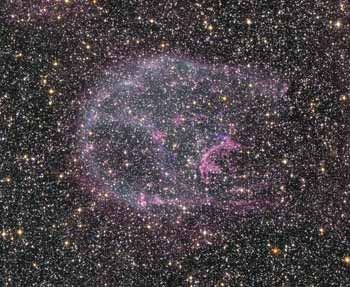Complex bundles of glowing gas hovering among many stars in an image of a supernova remnant, the material ejected from the explosion of a massive star that occurred about 3,000 years ago

Complex bundles of glowing gas hovering among many stars in this image of a supernova remnant, the material ejected from the explosion of a massive star that occurred about 3,000 years ago. This titanic explosion occurred in the Large Magellanic Cloud, a nearby galaxy about 160 light years away. This processed image of N132D includes visible-light data taken in January 2004 by the Hubble Space Telescope's Advanced Survey Camera, and an X-ray image taken in 2000 by the CCD spectrometer.
The complex structure of N132D is due to the propagation of the shock wave from the explosion and it affects the interstellar gas in the Large Magellanic Cloud. Supernova remnants such as N132D provide information on the evolution of stars and the creation of chemical elements such as oxygen through reactions in the nuclei of atoms in the cores of stars.
For information on the website of the Hubble Space Telescope Scientific Institute
